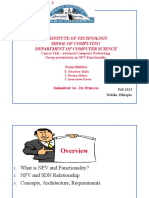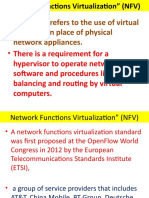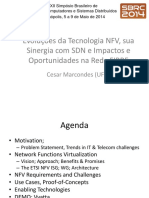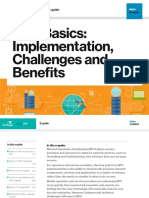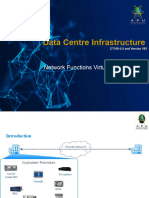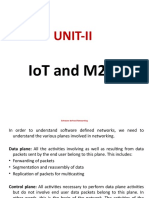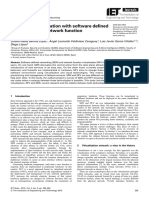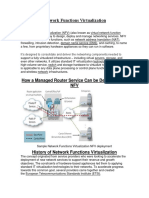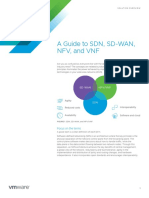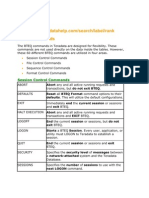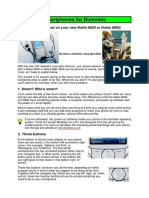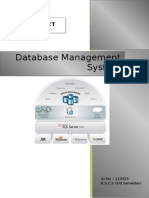Software Defined Networks
What is NFV?
Network functions virtualization (NFV) is the replacement of network appliance hardware
with virtual machines.
The virtual machines use a hypervisor to run networking software and processes such as
routing and load balancing.
NFV allows for the separation of communication services from dedicated hardware, such
as routers and firewalls.
This separation means network operations can provide new services dynamically and
without installing new hardware.
Deploying network components with network functions virtualization takes hours instead
of months like with traditional networking.
Also, the virtualized services can run on less expensive, generic servers instead of
proprietary hardware.
� Contd…
If a customer wants to add a new network function, the service provider can simply
spin up a new virtual machine to perform that function.
For example, instead of deploying a new hardware appliance across the network to
enable network encryption, encryption software can be deployed on a standardized
server or switch already in the network.
This virtualization of network functions reduces dependency on dedicated hardware
appliances for network operators, and allows for improved scalability and
customization across the entire network.
Different from a virtualized network, NFV seeks to offload network functions only,
rather than the entire network.
�Contd…
1. Fast standard hardware Software based devices
Routers, Firewalls, Broadband Remote Access Server (BRAS)
2. Function Modules (Both data plane and control plane)
DHCP (Dynamic Host control Protocol), NAT (Network Address
Translation), Rate Limiting, etc.
� Four Innovations of NFV
Ref: Introduction to Network Function Virtualization by Prof. Raj Jain, Washington University in Saint Louis.
� Need of NFV
1. Service provision within the telecommunications industry has traditionally been based on
network operators deploying physical proprietary devices and equipment for each
function that is part of a given service.
2. However, the requirements by users for more diverse and new (short-lived) services with
high data rates continue to increase.
3. Therefore, Telecommunication Service Providers (TSPs) must correspondingly and
continuously purchase, store and operate new physical equipment.
4. This does not only require high and rapidly changing skills for technicians operating and
managing this equipment, but also requires dense deployments of network equipment
such as base stations.
5. All these lead to high CAPEX and OPEX for TSPs.
� Contd…
With the help of NFV, it becomes possible to separate communication services
from specialized hardware like routers and firewalls.
This eliminates the need for buying new hardware and network operations can
offer new services on demand.
With this, it is possible to deploy network components in a matter of hours as
opposed to months as with conventional networking.
Furthermore, the virtualized services can run on less expensive generic servers.
�Contd…
1. Virtualization: Use network resource without worrying about where it is
physically located, how much it is, how it is organized, etc.
2. Orchestration: Manage thousands of devices.
3. Programmable: Should be able to change behavior on the fly.
4. Dynamic Scaling: Should be able to change size, quantity.
5. Automation
6. Visibility: Monitor resources, connectivity
7. Performance: Optimize network device utilization
8. Multi-tenancy
9. Service Integration
10. Openness: Full choice of Modular plug-ins
��The vision of classical network appliance to virtual network function
� NFV
architectural
framework
�Advantages
•Pay-as-you-go: Pay-as-you-go NFV models can reduce costs because businesses
pay only for what they need.
•Fewer appliances: Because NFV runs on virtual machines instead of physical
machines, fewer appliances are necessary and operational costs are lower.
•Scalability: Scaling the network architecture with virtual machines is faster and
easier, and it does not require purchasing additional hardware.
�Basic SDN
and NFV
interface
abstraction
� Contd…
Virtual Infrastructure Manager (VIM) plays an integral role in NFV framework.
It normally controls and manages NFV infrastructure storage, computing, and
network resources.
It also keeps a mapping of allocation of virtual resources to physical resources,
and manages virtual networks, links, and ports.
Virtual Network Function Manager (VNFM) is capable of handling multiple
Virtual Network Functions (VNFs) by using Element Management System
(EMS).
To ensure an adequate availability of computing, storage and network resources,
NFVO can either work directly with VIM or through VNFM.
�Virtualization
Virtualization is a broad concept that refers to the creation of a virtual version of
something, whether hardware, a software environment, storage, or a network.
In a virtualized environment there are three major components: guest (virtual
machines), host (physical machines), and virtualization layer.
The guest represents the system component that interacts with the virtualization
layer rather than with the host.
The host represents the original environment where the guest is supposed to be
managed.
The virtualization layer is responsible for recreating the same or a different
environment where the guest will operate.
��Virtualization
Reference
Model
�A General Architecture
�Types of Hypervisors
�Detailed Representation
�NFV and SDN Relationship
Concept of NFV originated from SDN
Introduced by European Telecommunications Standards Institute (ETSI).
NFV and SDN are complementary.
One does not strictly depend upon the other.
You can do SDN only, NFV only, or SDN and NFV.
Both have similar goals but approaches are very different.
Management/virtualization of large networks becomes easier with SDN
SDN needs new interfaces, control modules, applications. NFV requires
moving network applications from dedicated hardware to virtual
containers on commercial-off-the-shelf (COTS) hardware.
NFV is present. SDN is the future.
